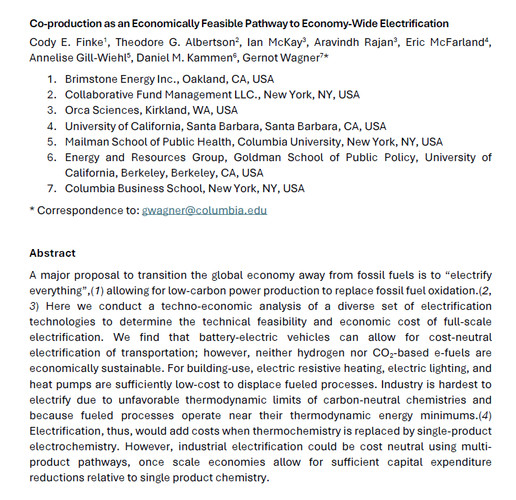Geoengineering is a bonkers plan, but it may be needed to tackle global warming
Wishful thinking does not make for smart policy

Solar geoengineering is nuts.
That, at least, is the reaction of many who hear about it for the first time. And how can it not be? Serious scientists are talking about deliberately trying to reflect a small fraction of sunlight back to space in order to cool planet Earth.
But calling it ‘nuts’ is beside the point. The real question is: nuts compared to what? Isn't it insane to be pumping billions of tons of carbon dioxide into the atmosphere year after year, hoping it will be fine in the end?
We have known for years, even decades, that things won’t turn out fine if we keep doing this. Claiming otherwise is willful blindness.
That’s part of the context in which we need to put solar geoengineering. There have been amazing advances in our attempts to reduce carbon emissions, especially as of late. Costs of clean energy have been coming down faster than expected. Solar photovoltaic costs have famously declined by over 80 percent since 2008.
That’s encouraging, and we shouldn’t detract from any of that. But here, too, the question is: good news compared to what?
We can’t ignore the fact that the more we learn about the climate problem, the worse things seem to get. That’s the future we are barreling towards. It’s also the only relevant scenario for discussing solar geoengineering.
Making the planet slightly brighter
The technical term for solar geoengineering is albedo modification. In practice, it works much like wearing white in the summer: White reflects sunlight and cools what’s underneath. The idea is all about making the planet ever-so-slightly more reflective to help cool it. Painting roofs white is one version. Doing so can help cool entire cities, but it won’t cool the planet, at least not by much.
Another, significantly more powerful version mimics what volcanoes have been doing forever: reflect sunlight by injecting sulfur dioxide into the stratosphere.
Mount Tambora did just that 201 years ago, leading to “the year without summer” 200 years ago. Indirectly Tambora gave us both The Vampyre and Frankenstein, as John William Polidori and Mary Shelley were forced to spend much of their Swiss summer holiday indoors.
A bit less dramatic (and much-better studied), Mount Pinatubo exploded in the Philippines in 1991. In 1992, global average temperatures decreased by about half a degree Celsius, almost a degree Fahrenheit.
So yes, we know the mechanism works in principle. Now, no one is proposing to actually mimic volcanoes. The idea is to inject small amounts of aerosols into the stratosphere directly. Scientists have begun looking into making this work in practice.
Would it be better if we didn’t have to discuss the topic? Maybe. But wishful thinking does not make for smart policy.
In the end, it’s all about tradeoffs. On its own, pollution is bad. Full stop. But of course, pollution is not an absolute bad. It took some polluting to leave the caves. It took pollution to produce the polio vaccine. It takes pollution to produce the smart phones young Ghanaian entrepreneurs use to run their businesses.
Pollution, in short, has been a byproduct of processes that have helped make our lives a lot easier, longer, and better. The traditional tradeoff often pits reducing pollution against economic growth. We must tolerate a bit of pollution, the story goes, to have economic development. That is less and less true as cleaner technologies become cheaper, but tradeoffs are still present.
Here’s another tradeoff: between traditional air pollution and climate change. This year, over three million people will die globally because of air pollution. Many of these deaths are caused by sulfur dioxide pollution from the burning of fossil fuels. Europe and the United States have led the charge against such pollution. Europe, in particular, has slashed sulfur dioxide pollution by 75 percent since the 1970s.
The unintentional consequence of these emissions cuts is a half a degree Celsius increase in temperatures in the Arctic, almost a degree Fahrenheit, since 1980, because fewer sulfur dioxide particles are now reflecting sunlight back to space.
The tradeoff between sulfates in the air and decreased global warming is well known. It pits direct human health impacts against the effects of climate change. And none of that means we should not decrease harmful sulfur dioxide pollution — we must, for the benefit of society now.
But we should do so while being conscious about the tradeoffs with global warming. This is where the tradeoffs — and morality — of solar geoengineering enter in the clearest possible way. Imagine this scenario:
One, slash sulfur pollution in the lower atmosphere, where it causes acid rain and kills millions a year.
Two, inject roughly a fiftieth of the amount of sulfates into the upper atmosphere, where it causes virtually no direct harm to humans but helps keep global warming in check.
This is what solar geoengineering could help accomplish.
Yes, I am an environmentalist, and I am advocating for (slightly) more pollution. But I’m not doing so lightly. I’m doing so while being painfully aware of the tradeoffs involved.
If we could decrease sulfur pollution significantly tomorrow — cheaply and effectively — and do so without increasing global temperatures at the same time, sign me up.
If we could slash both global sulfur and carbon dioxide pollution without increasing global temperatures, even better. But we can’t.
And that’s not because cutting the pollution in the first place is hard. It’s because there’s a real tradeoff between sulfur and carbon dioxide. Sulfur in the lower atmosphere reduces global temperatures now. Slashing carbon emissions today won’t decrease temperatures until much later. Because of the long lifetime of every molecule of carbon dioxide, even if carbon emissions were cut to zero today, temperatures would still increase for decades to come.
Sea levels, too, will increase well into the next century and perhaps beyond. All because it’s the carbon we have already put into the atmosphere that will cause many of our future problems.
It’s precisely these tradeoffs that must be front and center when we talk about solar geoengineering. None of this is easy. And no, solar geoengineering is notthe solution to climate change. We must cut carbon pollution. And we certainly must not slide toward solar geoengineering blindly.
The time to research solar geoengineering is now. Whether we like it or not, climate change is too big a problem not to.
Gernot Wagner is a research associate and lecturer at Harvard University, and co-author of the book Climate Shock (Princeton, March 2015). He spent eight years at Environmental Defense Fund, most recently as its lead senior economist. This op-ed first appeared on Mashable.com.
Note on the headline: Mashable originally published the piece under the heading: "Geoengineering is a bonkers plan, but it may be needed to tackle global warming." Within a few hours of publication, the headline changed to: "Solar geoengineering could actually help solve global warming." I'm using the original headline here.

